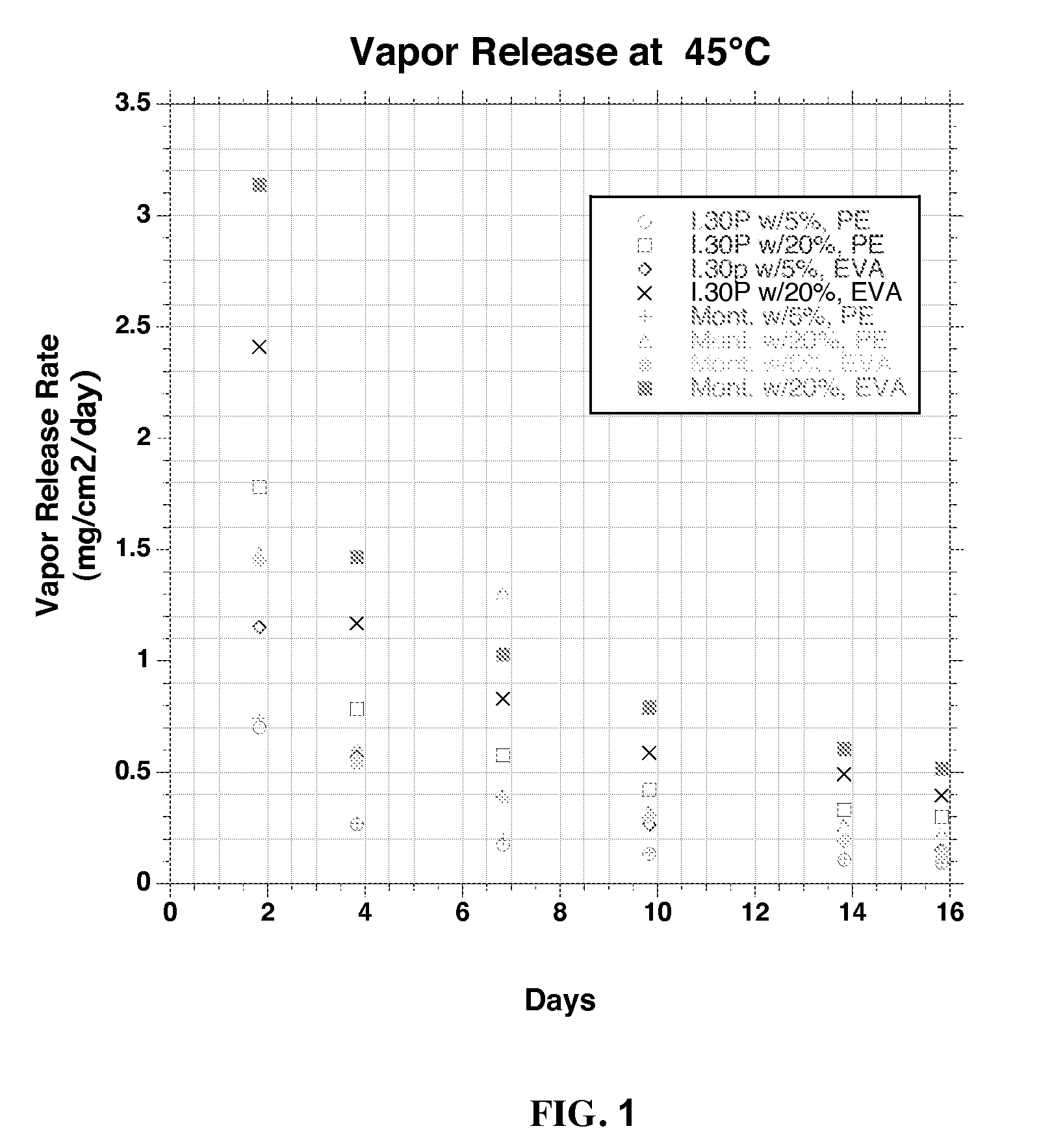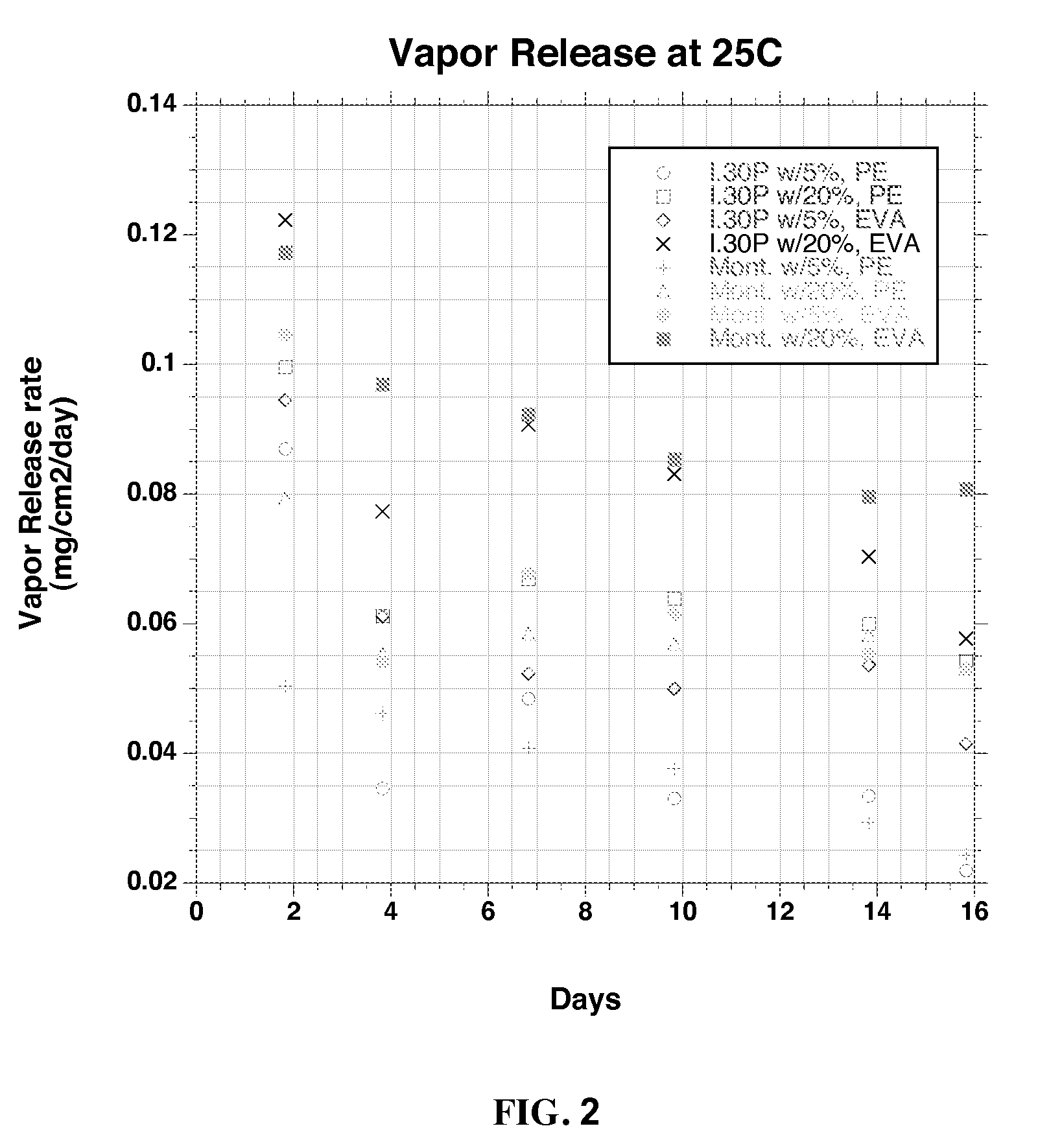Methods and Products to Protect Against Root Intrusion and Plant and Root Growth
- Summary
- Abstract
- Description
- Claims
- Application Information
AI Technical Summary
Benefits of technology
Problems solved by technology
Method used
Image
Examples
example 1
2,6-Dinitroaniline / Nanoparticle-Loaded Fibers
[0050]In preparation for spinning loaded fibers, the 2,6-dinitroaniline-loaded nanoclay was prepared from Dow Agro Science's Treflan® (Trifluralin or TFN) and Nanocor's I.30P nanoclay. The sorption method of U.S. application Ser. No. 10 / 816,095 was used. The particle size requirement was that the sample passes through a #60 U.S. Sieve (<250 microns). The product was further ground to about 25-35 micron size. Pelletized polypropylene material was used for the extrusion and spinning of fibers. It was exfoliated by blending the loaded nanoclay with Microthene® polypropylene and extruding the mixture into the melt spinning device. During melt spinning to prepare 77-micron diameter fiber, the platelets became oriented on passing through the spinnerettes.
[0051]A geotextile product was prepared by loading the trifluralin / nanoclay / polypropylene fiber material into a polyester matrix that was adjusted to provide between 4 and 8% TFN (w / w) for the ...
example 2
Trifluralin / Nanoparticle-Loaded Film and Sheet
Holding Capacity
[0063]Trifluralin was preheated above its melting point and slow-blended into preheated clay or nanoclay, using the procedure detailed in U.S. patent application Ser. No. 10 / 816,095, to wit:
[0064]Trifluralin (Treflan® from Dow Elanco) was heated to 68°-70° C., at which point it melted. A Blakeslee mixer (Model B-20) was adapted to have its interior heated to the desired temperature. The temperature of the clay and added pesticide within the bowl was maintained using heating straps attached to the outside mixing bowl (heaters controlled at 65° C., actual temp of stirred clay pesticide mixture was 50° C.). The nanoclay was slowly added to the mixer bowl at a rate of 5 mL / min-10 mL / min, with the mixer at a low (1) blending setting. Addition of the trifluralin was halted when the mixture just started to ball up. Mixing was continued for another hour at a higher mixing setting to break smaller clumps. The mixture then was cool...
example 3
Spray Coating with Trifluralin-Loaded Nanoparticles
[0074]In preparation for spraying trifluralin-loaded coatings, trifluralin-loaded nanoclay was prepared from Dow Agro Science's Treflan® trifluralin and Nanocor's I.30P nanoclay. The sorption method of U.S. patent application Ser. No. 10 / 816,095 was used. The particle size requirement was that the initial output passes through a #60 U.S. Sieve (<250 microns). The initial product was then ground and sieved to obtain particles that are less than 35 microns.
[0075]Rhino Linings, Inc.'s Tuff Stuff® sprayed-on polyurethane coating formulations that have the correct performance characteristics was selected for spray application. Its characteristics are 100 percent solids (therefore, no volatile organic solvent problems), cures in less than 10 minutes, have excellent longevity even in outdoor applications, and has excellent impact and abrasion resistance.
[0076]Rhino's spraying equipment has a single motor driving two separate fixed-ratio pr...
PUM
 Login to View More
Login to View More Abstract
Description
Claims
Application Information
 Login to View More
Login to View More - R&D
- Intellectual Property
- Life Sciences
- Materials
- Tech Scout
- Unparalleled Data Quality
- Higher Quality Content
- 60% Fewer Hallucinations
Browse by: Latest US Patents, China's latest patents, Technical Efficacy Thesaurus, Application Domain, Technology Topic, Popular Technical Reports.
© 2025 PatSnap. All rights reserved.Legal|Privacy policy|Modern Slavery Act Transparency Statement|Sitemap|About US| Contact US: help@patsnap.com


